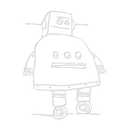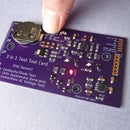Introduction: Orbital Sound
A device that makes a noise without the use of batteries, that's small light and portable.
This device makes use of resonance in a cavity.
As its an acoustic device we need to provide it with air.
But rather than applying the air by blowing into it we will propel the device at high speed to force the air.
Supplies
Step 1: Theory
If both ends of a tube in a musical instrument are uncovered its an open end air column. E.g. woodwind instrument
The resonant frequency depends on the dimensions of the air column in conjunction with the air speed and temperature.
Anti-nodes or maximum vibration exist at the open ends of the air column with the length of the air-column half the wavelength of the fundamental frequency.
The frequency would be calculated as f =V/2L = 343.7 m/s /(2*0.012 m) = ~14.32kHz
However, being a sphere its a more complex process.
If we cover one hole the sphere approximates to a Helmholtz Resonator without a neck.
With calculated frequency of 72.6*SQRT(0.002/(0.012^3)) = ~2.47kHz
Both frequencies are within the audible range of 20Hz to 20kHz although there are variation between individuals particularly at the higher end.
However, the spinner is not travelling at a constant speed but accelerating and decelerating thus affecting the intensity and frequency of the sound.
Additionally, multiple harmonics are also produced at higher frequencies than the fundamental.
For the design spheres rather than cylinders are used as they offer better stability in motion offering less air resistance and being more streamline..
When the spinner is turning air passes quickly over the outer surface creating a pressure difference attempting to pull air out of the sphere conversely the lower pressure created attempts the suck the air back in.
These oscillations of the air repeat at long as the spinner rotates.
Step 2: Design
The device will be required to rotate rapidly without the use of batteries or electrical motors.
This will be accomplished with the energy stored in a wound string with an offset axis.
In order for the device to rotate smoothly it is required to be balanced and symmetrical, a circular object fits the bill.
The circular object will normally rotate in the vertical plane.
As this device was to be 3D printed consideration needs to be given to the overall shape, size, strength and aerodynamics.
The circular object comprises a supporting dual hoop wheel with 4 spokes and a central hole.
But this on its own is not what will make the sound we desire.
In order to make the noise we require some resonators.
The resonators will be hollow spheres with two holes, one at each of horizontally opposite aligned poles.
A total of four resonators will be included which will fit between the gap of the two spokes.
Two small oppositely placed rings will be placed close to the centre through which the string will be laced.
In order to negate the requirement for supports and ensure the spheres are hollow.
The device (spinner), will be created in two halves in order to print it flat and then the two halves will be stuck together.
Printing in two halves enables the spheres to be inspected internally for issues.
Design details:
Radius of the outer hoop is 32 mm
Radius of the inner hoop is 18 mm
Radius of the spheres is 7 mm with wall thickness 1 mm.
Radius of the holes in the spheres is 1 mm.
Spokes and hoop thickness is 2 mm.
Once the design is complete, its rendered in high resolution to create a smooth print then a STL file is generated.
Attachments
Step 3: Print Preparation
Load Cura (used for this project) or similar splicing application.
Open the STL file.
As we require two halves to create the completed spinner we need to create a multiple of the object.
This is accomplished by right clicking the object and selecting "Multiplying selected object".
Enter 1 in the dialog box (as we only require one object), and select OK.
The additional object will be placed on the bed.
Right click on an object and select "Select All Objects".
This will allow all the objects to be moved as a group to enable centring on the bed.
Once the objects are positioned assign the printer settings.
In the case the settings are:
Layer Height - 0.15 mm
Infill - Tri-Hexagon
Infill Density - 50%
Base Adhesion - Brim
No supports.
Filament - PLA
Weight - 9 grams
Print Time - 1 hour 22 mins
Save the Gcode file for the printer.
Step 4: Printing
Print using PLA or other suitable filament in a colour of your choice.
You could even print the two halves in different colours.
Step 5: Post Processing
Once printed remove the Brim.
Remove any blemishes or strings from the surface by filing, sanding or cutting.
Sand the flat side of the spinners to remove any roughness as this will help ensure the surfaces fit together evenly and prevent gaps in the spheres that will affect the sound due to air leakage.
Regarding leaks, the 3D printing process is known to produce small gaps between and in layers as a result these will require filling in.
The gaps are filled in with lacquer, enamel paint or epoxy resin this is applied both internally and externally and left to dry.
If necessary clear out the holes in the spheres with a 2 mm drill bit.
Clear out or widen the holes for the strings as required.
Following this a suitable plastic glue is applied to the flat surfaces of the two halves and these are bonded together.
The spinner is complete.
Step 6: Final Assembly
Measure approximately 1 metre (39 inches), of string/twine.
Thread the cord through both string holes to form a loop and tie the ends together with a suitable knot, I used a square (reef) knot.
Handles.
Subject to the string diameter and finish you may wish to add handles or use gloves to prevent the string rubbing your fingers.
Handles may be created from the following:
Two large body felt tip pens (loop the cord around the body), dowels (looped with cord or through holes), or circular disc cut from wood (loop cord through hole and body). Other options may be considered such as 3d printed handles.
Step 7: Operation
Before use and periodically during use check that the spinner has no issues and that the string is not fraying.
If any issue are found better to reprint a new spinner and to re-thread with a new string.
As a precaution wear eye protection in case there is a failure of the spinner or the string should snap.
Without handles:
Stretch out the string loop to form two parallel lines with index and middle fingers of each hand looped through the turns at the extremes
Clasp the string in closed fingers.
With handles.
Stretch out the string loop to form two parallel lines clasp the handles in closed fingers.
The rest of the process is applicable to either method.
Centre the spinner along the string so as to be positioned equidistant between your hands by sliding along the string loop.
Hold the string loosely with forearms parallel such that the spinner and string form a "V" shape with the spinner at the bottom of the "V".
The string is tensioned by rotating both hands in unison (creating small arcs), maintaining the "V" shape (as far as possible); as the string tightens it should shorten as it is wound.
Once the string starts to produce kinks, it is would sufficiently.
At this stage maintaining parallel forearms pull your hands outward away from each other.
The spinner will start to spin unwinding the twist previously applied whilst simultaneously whistling.
Once unwound the momentum will cause the string to wind its self in the opposite direction but at the same time losing momentum and slowing down.
During this stage relax the opposing pull between your hand and pull them apart again causing the spinner to rotate in the opposite direction picking up speed in the process.
Repeating the process with a smooth co-ordinated action will keep the spinner rotating and whistling.
It may take a little practice the get the spinner to rotate.
It's also a good exercise for your arms.
Attachments

Runner Up in the
Audio Challenge













